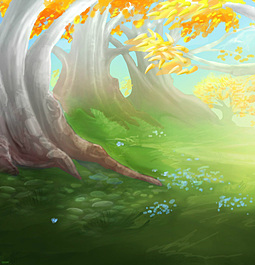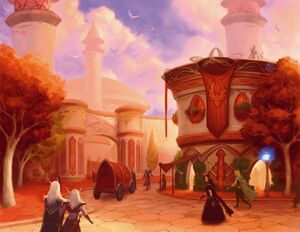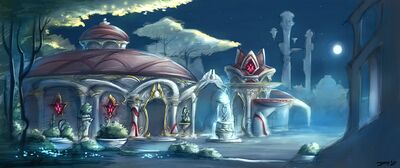User:Armen80721/Tol'vir/Kingdom of Quel'Thalas
 | |
| Capital(s) |
|
| Races |
|
| Government | Interregnum (ostensibly); hereditary monarchy (formerly)[1] |
| Ruler(s) |
|
| Major settlements |
|
| Minor settlements |
|
| Affiliation |
Independent |
Quel'Thalas is a lush forest region north of the Kingdom of Lordaeron (in some cases it is implied to be a separate continent[2]). The map published in the Warcraft II manual shows several regions including Khaz Modan, Quel'Thalas, and Lordaeron, each sharing the same font size. Azeroth is shown with a larger font size.[3]
Following their exile from Darnassian society and their swift abandonment of the region of Tirisfal Glades, the high elves under the leadership of Dath'Remar Sunstrider founded the nation of Quel'Thalas to the north. Soon, Quel'Thalas became a shining monument to high elven prowess; the land was magically bathed in an eternal springtime. The high elves created the Sunwell, their own version of the Well of Eternity, which empowered the citizens of Quel'Thalas from then onwards. The elves earned the enmity of the forest trolls of Zul'Aman, under the Amani Empire, who viewed the elves as usurpers. After several long-spanning conflicts, High King Anasterian Sunstrider presided over the Troll Wars, which dealt the Amani a defeat they would never truly recover from. In its seclusion, Quel'Thalas continued to prosper with the protection of the Sunwell (even rendering the invasion of the Amani remnants and their Old Horde allies fruitless), until the kingdom's formidable defenses were bypassed by the treacherous scion of Lordaeron: Prince Arthas Menethil, and his undead Scourge.[4]
The high elves of Quel'Thalas were nearly scoured from Azeroth; the king perished before Arthas's dark powers, the Sunwell was destroyed, and the bulk of their people were slaughtered. In the wake of this devastation, the king's son Prince Kael'thas Sunstrider proclaimed the surviving high elves reborn from the ashes of their shattered kingdom and people, as the blood elves.[5] The sin'dorei worked tirelessly to reclaim their homeland from the lingering undead, and would eventually succeed in taking back much of their country, the capital of Silvermoon included. In a dramatic turn of events, a twisted Prince Kael'thas returned to beauteous Quel'Thalas -- attempting to summon the Burning Legion via the Sunwell. The prince's dark ambitions were not to be realized, however, and the Sunwell itself would ultimately be returned to the blood elves by the Prophet Velen, an act that may rebirth the soul of the nation.[6]
After the purge of the blood elves from Dalaran, Lor'themar has left the Horde. He had summoned the Magisters, the Farstiders, the Sunfury, the Blood Knights and the Sunreavers to put an end to the treat of the forest trolls in Zul'Aman. They successfully captured Zul'Aman and enslaved the Amani. Later on, the blood elves continued their campaign against the Scourge in Ghostlands and the Kirin Tor in Isle of Thunder.
The kingdom of Quel'Thalas is currently led by its regent, Lor'themar Theron, and the revived Silvermoon Council, following the fall of the royal family.
History
Founding
The high elves, led by Dath'Remar, left Kalimdor behind them and challenged the storms of the Maelstrom. Their fleets wandered the wreckage of the world for many long years, and they discovered mysteries and lost kingdoms along their sojourn. Dath'Remar, who already had the name Sunstrider (or "he who walks the day"), sought out places of considerable ley power upon which to build a new homeland for his people. His fleet finally landed on the beaches of the kingdom men would later call Lordaeron. Forging inland, the high elves founded a settlement within the tranquil Tirisfal Glades. After a few years, many of them began to go mad. It was theorized that something evil slept beneath that particular part of the world, but the rumors were never proven to be true. The high elves packed up their encampment and moved northward towards another land rich with ley energies.
As the high elves crossed the rugged, mountainous lands of Lordaeron, their journey became more perilous. Since they were effectively cut off from the life-giving energies of the Well of Eternity, many of them fell ill from the frigid climate or died from starvation. The most disconcerting change, however, was the fact that they were no longer immortal or immune to the elements. They also shrank somewhat in height, and their skin lost its characteristic violet hue. Despite their hardships, they encountered many wondrous creatures that had never been seen in Kalimdor. They also found tribes of primitive humans who hunted throughout the ancient forestlands. However, the direst threat they encountered were the voracious and cunning forest trolls of Zul'Aman. These moss-skinned trolls could regenerate lost limbs and heal grievous physical injuries, but they proved to be a barbaric race. The Amani empire stretched across most of northern Lordaeron, and the trolls fought hard to keep unwanted strangers from their borders. The elves developed a deep loathing for the vicious trolls and killed them on sight whenever they were encountered. After many long years, the high elves finally found a land which was reminiscent of Kalimdor. Deep within the northern forests of the continent, they founded the kingdom of Quel'Thalas ("High Kingdom" or "High Home")[7] and vowed to create a mighty empire which would dwarf that of their kaldorei cousins. Unfortunately they soon learned that Quel'Thalas was founded upon an ancient troll city that the trolls still held to be sacred. Almost immediately, the trolls began to attack the elven settlements en masse.
The elves, unwilling to give up their new land, utilized the magics which they had gleaned from the Well of Eternity and kept the savage trolls at bay. Under Dath'Remar's leadership, they were able to defeat the Amani warbands that outnumbered them ten to one. Some elves, wary of the Kaldorei's ancient warnings, felt that their use of magic might possibly draw the attention of the banished Burning Legion. Therefore, they decided to mask their lands within a protective barrier which would still allow them to work their enchantments. They constructed a series of monolithic Runestones at various points around Quel'Thalas which marked the boundaries of the magic barrier. The Runestones not only masked the elves' magic from extra-dimensional threats, but helped to frighten away the superstitious troll warbands as well.

As time wore on, Quel'Thalas became a shining monument to the high elves' efforts and magical prowess. Its beauteous palaces were crafted in the same architectural style as the ancient halls of Kalimdor, yet they were interwoven with the natural topography of the land. Quel'Thalas had become the shining jewel that the elves had longed to create. The Convocation of Silvermoon was founded as the ruling power over Quel'Thalas, though the Sunstrider Dynasty maintained a modicum of political power. Comprised of seven of the greatest high elf lords, the Convocation worked to secure the safety of the elven lands and people. Surrounded by their protective barrier, the high elves remained unmoved by the old warnings of the Kaldorei and continued to use magic flagrantly in almost all aspects of their lives.
For nearly four thousand years the high elves lived peacefully within the secluded safety of their kingdom. Nevertheless, the vindictive trolls were not so easily defeated. They plotted and schemed in the depths of the forests and waited for the numbers of their warbands to grow. Finally, a mighty troll army charged out from the shadowy forests and once again laid siege to the shining spires of Quel'Thalas.
The Troll Wars
When the Amani returned, they struck back with a vengeance. The trolls besieged Quel'Thalas for many years, bringing the elven kingdom to its knees. In desperation, with defeat nearly imminent, the high elves turned to their southern neighbors: The human empire of Arathor.
The human tribes had recently been united under the rule of Thoradin, establishing their capital city of Strom (present day Stromgarde) in the highlands of southern Lordaeron. While they too suffered at the hands of the trolls, it was not until ambassadors from Quel'Thalas arrived that Thoradin realized how desperate the elves' situation was. The elves agreed to train one hundred men in the arts of magic in exchange for Thoradin pledging military aid. Thoradin, though distrustful of magic, agreed to send aid to the elves out of necessity - realizing that once Quel'Thalas had fallen, Arathor would be next. After the battle that forever broke the legions of Zul'Aman, the elves pledged an oath of loyalty and friendship to Thoradin and his bloodline.
The Second War
Nearly three thousand years later, shortly after the fall of the Kingdom of Azeroth, Anduin Lothar - the last blood descendant of King Thoradin - led his people across the Great Sea to Lordaeron, where he went before King Terenas and warned of the coming of the Orcish Horde. Terenas immediately called a council of the neighboring kings which led to the formation of the Alliance of Lordaeron. With Lothar named Supreme Commander, Terenas sent a missive to King Anasterian Sunstrider - himself a veteran of the Troll Wars millennia before - informing him of Lothar's lineage and the request for aid to the Alliance. At first, Anasterian reluctantly sent a token display of support in the form of a party led by Alleria Windrunner.
Not long afterwards, when Orgrim Doomhammer led the Horde's invasion of Quel'Thalas and began burning the edges of the Eversong Woods, it was discovered that the Horde was being aided by the elves' mortal enemies, the Amani, led by the cunning Zul'jin. Alleria brought the head of a freshly slain troll warrior to the Convocation of Silvermoon, throwing it at Anasterian's feet. This provoked an intense rage within the King of Quel'Thalas, and he immediately called for the mobilization of his armies to battle the Horde. The effort was led by Sylvanas Windrunner, Ranger-General of Silvermoon.
In the wake of the Second War, humanity began to distance itself from Quel'Thalas;[8] and in turn the high elves came to view their deterioating Alliance with increasing coldness.[9] The tension eventually came to head when King Anasterian withdrew his support from the Alliance entirely. The official stance was that the humans' poor leadership resulted in the burning of Eversong Woods (even though Terenas reminded him of the many humans who gave their lives to protect Quel'Thalas); in addition, with Lothar dead and the Horde defeated, Anasterian believed that the debt to Thoradin and his descendants was repaid. With few exceptions - including the elven priests and sorceresses, as well as Anasterian's son and heir, Prince Kael'thas, a member of the Kirin Tor of Dalaran - the majority of the elven race shut themselves inside their enchanted kingdom.
Anasterian's decision to secede was the catalyst that led to both King Genn Greymane and the nation of Stromgarde to follow the high elven king's example - a domino effect that would soon have dire repercussions for the humans and elves alike.[4]
The Fall of Quel'Thalas

Almost fifteen years later, the Plague of Undeath broke out in Lordaeron. Terenas' son Arthas, a paladin trained by Uther the Lightbringer himself, made efforts to stop the Plague from turning his beloved people into mindless undead raised to serve the Lich King, master of the Scourge. Instead, the whole chain of events appears to have been engineered by the Lich King himself to find a suitable host for his bodiless mind, and Arthas fell into despair and eventually madness. Travelling to Northrend, he forfeited his soul to the Lich King upon taking up the runeblade Frostmourne.
Now the greatest of the Lich King's death knights, Arthas traveled back to his homeland, murdered his father and all but obliterated the Kingdom of Lordaeron. Afterwards, he was tasked by Tichondrius, the leader of the Dreadlords and the Lich King's chief jailor, to resurrect the necromancer Kel'Thuzad - whom Arthas had killed not long before - so he could fulfill his appointed duty of summoning Archimonde into Azeroth. Tichondrius also told Arthas that there was only one suitable place to resurrect Kel'Thuzad - the mystic Sunwell, the source of the high elves' magic, deep inside Quel'Thalas.
To reach the Sunwell, Arthas needed an insider, someone who could allow him to bypass the magical defenses of Quel'Thalas; he found one in Dar'Khan Drathir, a member of the Convocation of Silvermoon. Dar'Khan, an egotistical and embittered man, believed he deserved more than he was receiving. Arthas preyed upon his ego, promising Dar'Khan untold power in exchange for his aid, and his loyalty. With the backing of his "Blessed Lord Arthas", Dar'Khan provided the Scourge with two powerful artifacts - the Stone of Light and the Stone of Flame - that had warding powers against the undead, allowing the Scourge armies to circumvent Quel'Thalas' formidable defenses. Thus, Arthas led the Scourge in a march of death up a path that today is known as the Dead Scar, across the Elrendar River into Eversong Woods, destroying one of the protective runestones on the edges of the forest.
The elves, in an attempt to stop the blight from spreading further into Eversong Woods, set the area around the destroyed runestone to the torch. But the armies of the Scourge pressed on, breaking through the Elfgates and through Silvermoon itself. Ranger General Sylvanas Windrunner led the defense as best she could, but she fell to the power of Frostmourne. In a cruel gesture of dominance, Arthas took Sylvanas' lifeless body and ripped her spirit from it, creating the first banshee. Even the blade Quel'Delar, King Anasterian and the Convocation of Silvermoon were no match for Arthas' legions, slaughtered with their people by the relentless tide of the mindless undead.
With Silvermoon in ruins and the elves broken and scattered, Arthas fulfilled his task and submerged the corpse of Kel'Thuzad within the waters of the Sunwell, fouling the potent waters of Eternity; the necromancer returned to the world of the living as a sorcerous lich.
Betrayals and Second Chances
When word of Quel'Thalas' fall reached Dalaran, Prince Kael'thas - now the last of his bloodline and de jure leader of the high elves - returned to his homeland, gathered all the survivors he could and destroyed the Sunwell. The elves rejoined the Alliance armies, where they called themselves blood elves in honor of their fallen. But the Alliance began to look down on their elven "comrades". The ethnocentric Grand Marshal Garithos, the leader of the Alliance remnant, often gave the blood elves tasks that either beneath their capabilities as warriors or - worse - suicidal. Kael'thas was forced to call upon the aid of the night elves (led by Malfurion Stormrage and Tyrande Whisperwind, hunting for Malfurion's brother Illidan) and, later, Lady Vashj and the naga.
When Garithos discovered the naga had aided Kael and his brethren, he sentenced them to death for treason. Kael and his comrades were rescued by Vashj and her naga, who took them to Illidan in the wastes of Outland. With the promise of as much magic as they required, Kael'thas pledged the loyalty of the blood elves to Illidan's cause. Settling in Outland with the rest of Illidan's forces, Kael'thas sent a magister named Rommath back to Quel'Thalas, with the promise that Kael'thas would one day return to lead the blood elves to paradise. Rommath joined up with Lor'themar Theron, Regent Lord of Quel'Thalas, and informed him of Kael'thas' command to prepare the blood elves for their journey into the "promised land" beyond the Dark Portal. To aid in that task, Rommath and the new order of Blood Magi he founded used very powerful magics to rebuild the eastern districts of the shattered city of Silvermoon to serve as the blood elven capital on Azeroth. Kael'thas also sent back M'uru to Quel'Thalas, a naaru guardian whom he had defeated in Tempest Keep. The blood elves learned to manipulate and harvest his holy energies, using them to empower a group of pseudo-paladins dubbed the Blood Knights.
Meanwhile, Dar'Khan Drathir had been killed by a group of blood elves, dragons and Sylvanas. Anveena' identity was promised to be kept in secret by Quel'Thalas' leadership.
Following failed negotiations with the Alliance, the blood elves have turned to the Horde for support. The Forsaken, in particular, are staunch supporters of the blood elves' membership in the Horde, as their queen, Sylvanas Windrunner, was Ranger General during the Scourge invasion and a good number of Forsaken are high elves who were killed in the war. Only one major obstacle preventing their becoming full members of the Horde remains: the Scourge that remain on the footsteps of Quel'Thalas, marching from their citadel of Deatholme at the southern terminus of the Dead Scar. There, the resurrected Dar'Khan Drathir directs the Scourge in Quel'Thalas; only his death would allow the blood elves to become equal members of the Horde.
Quel'Thalas would later be shaken by the sudden betrayal of Kael'thas, who had switched his loyalties to that of the Burning Legion. In a mad bid to summon his new master Kil'jaeden from the Isle of Quel'Danas, Kael'thas attacked his homeland to steal M'uru, and the Shattered Sun Offensive was formed to end the Prince's dark ambitions. Lady Liadrin travelled to Shattrath City, and pledged the blades of her Blood Knights to fighting alongside the newly-formed offensive and reclaiming Quel'Thalas. In a conversation with A'dal, she learns that M'uru had known of his role long before the blood elves had ever taken him; that he had given himself willingly to the sin'dorei, knowing that his demise would pave way to a brighter future for both them and their home of Quel'Thalas.[10]
Shortly after the demise of Prince Kael'thas, Kil'jaeden was pushed back to the Twisting Nether and the Isle of Quel'Danas was reclaimed. The Blood Knight matriarch Lady Liadrin and the draenei Prophet Velen arrived at the site of the Sunwell, tainted by both the Scourge and Kil'jaeden. As Liadrin lamented the fall of Quel'Thalas and the levels its people had sunk to in order to reclaim it, the prophet restored the Sunwell in a blaze of light, noting that this would be the first step to rebirthing the soul of the nation.[11]
Then and now
Quel'Thalas is currently ruled by Lor'themar Theron, who has continued to style himself as its Regent Lord following the death of Kael'thas. With the Isle of Quel'Danas back under blood elf control, a number of high elves have been allowed to make pilgrimages to their homeland in order to visit the renewed Sunwell. The Sunfury forces have also returned home.[12]
Quel'Thalas is likely the first target for the new Troll empire brewing in Zul'Aman. Ranger-general Halduron Brightwing has joined forces with Darkspear Chieftain Vol'jin and Vereesa Windrunner to counter this threat.
Following the Purge of Dalaran, Archmage Aethas Sunreaver (and the escaped Sunreavers themselves) returned home to Quel'Thalas. In response, the Thalassian leadership moved to assemble their forces, noting that the time had come for the blood elves to take matters into their own hands.
Notable leaders
| History | Highborne exile | Kingdom of Quel'Thalas | Fall of Quel'Thalas | Rise of the Blood Elves | ||||
|---|---|---|---|---|---|---|---|---|
| Ruler | Dath'Remar Sunstrider | Unknown | Anasterian Sunstrider | Kael'thas Sunstrider Lor'themar Theron |
Lor'themar Theron | Lor'themar Theron Silvermoon Council | ||
Quel'Thalas' regions
Zones in World of Warcraft
- Eversong Woods - Starting area for the blood elves (In the Burning Crusade)
- Ghostlands - Also known as the Blackened Woods (In the Burning Crusade)
- Isle of Quel'Danas, also known as the Sunwell Isle - location of the Sunwell; opened in Patch 2.4.0 (the RPG also states that it is the home of the dragonhawks of Quel'Danas).
Other regions
- Zul'Aman - Home of the Amani forest trolls (In WoW it's an instance within Ghostlands, instead of its own zone).
- Silvermoon - more of super region including, Silvermoon City all the way to Sunwell Grove(Quel'Danas).
- Blackened Woods - More of a super region including all areas south of the Silvermoon region (Eversong Woods and Ghostlands).
- Greenwood Pass (WC3)
- ^ In the Shadow of the Sun
- ^ Alliance Player's Guide, pg. 178: "Lordaeron (and the surrounding regions such as Quel'Thalas)..."
- ^ File:Second War Map.jpg
- ^ a b http://www.wow-europe.com/en/info/encyclopedia/429.xml
- ^ http://us.battle.net/wow/en/game/race/blood-elf
- ^ Sunwell Plateau epilogue
- ^ Lands of Conflict, pg. 113
- ^ Beyond the Dark Portal, pg 60
- ^ Beyond the Dark Portal, pg 60
- ^ [[1]]
- ^ Sunwell Plateau epilogue
- ^ In the Shadow of the Sun




